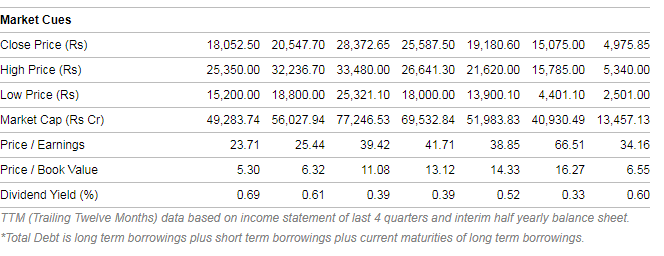Thank you. Do they provide any advance notice when they change from 5% to 10% for a particular stock?
Yes, they do. Here’s a recent example:
https://www.bseindia.com/markets/MarketInfo/DispNewNoticesCirculars.aspx?page=20190917-28
Thank you. One more question. If a stock hits the circuit breaker limit, how long is trading suspended for? Is it for the rest of the day or more or less?
It is usually suspended for the rest of the day.
All of my questions are because of a stock I own - CG Power. I bought it at 8.70. And I have been trying to sell it since yesterday. Yesterday, I tried selling it in the afternoon, but looks like it was inactive by then (probably because of the circuit breaker). Today, I placed a Market order (no price specified) at exactly 9:15 & the order hasn’t got executed - I am assuming it hit the circuit breaker in the pre-mkt time or right after the market opened. How will I be able to sell this? Should I place a sell order in premarket time? It says that in premarket, Market orders are prioritised after limit orders - I want to give a market order because I have no clue if price is going to fall or go up. Can circuit breaker be hit even before market opens at 9:15 - i.e. in the pre-market time?
This stock has been hitting circuit breaker practically every day for 3 weeks now. First 15 days, it was hitting up circuit breakers everyday - going up from 8 to 17. Now it’s been hitting the down breaker for 3 days.
I have some questions
-
What would be my best strategy to sell this on Monday, assuming trading on this is not possible for the rest of the day? Market or Pre-Market? Limit or Market order?
-
How do I know if a stock has hit the circuit filter for the day? For e.g. now do I need to check my order book every half hour for the rest of the day to check if my order has been fulfilled? If I know that there is no trading going to happen for the rest of the day, then I don’t need to.
-
Let’s say there is a stock which costs around Rs. 10 & it has a circuit filter of 5%. Morning, I go and place a buy order of Rs. 10.60 or a sell order for Rs. 9.40 for exactly 1 stock. I have now managed to trigger the circuit breaker & have stop trading for the rest of the day. I can do this everyday & I will just spend around 10 Rs a day to do this mischief. What is there to stop me from doing this?
EDIT: Update - my order went through after 15-20 minutes. But I would still like to know answers to my questions - I still have 50% of my CG Power stock let to sell.
If the price reaches circuit, the trading does not stop. Trading will stop only if there are no buyers at lower circuit or no sellers at upper circuit. You can always take the opposite trade.
Best chance of selling successfully would be limit order at lower circuit price. If there are buyers at that price for quantity more than sell quantity, the order will be executed.
Hmm. I was asking because @dineshssairam said it stops for the rest of the day - Investing Basics - Feel free to ask the most basic questions - #952 by dineshssairam
The idea of Circuit Breakers is to bring back normalcy to trading. Typically some grace period is given when the circuits are hit. Trading is stopped, but any trade done below circuit limits will allow the stock to be traded again. But if trades continue to be above the circuits, trading is halted for the day.
This blog post offers a simple explanation:
This doesn’t make sense. If trading is stopped then how can a trade be done below circuit limits?
Trading is stopped briefly (Few hours) and then resumed to see if normalcy has returned. If it hasn’t, then trading will cease for the day.
While evaluating companies like TATA motors should we consider share outstanding as the sum of the main company TATA motors + DVR + ADR?
Would the profit be distributed equally almost the shareholders of each of the shareholders?
Just want to ask one question
Why best of Indian companies trade at such high PE inspite of not so high growth rate (As compared to US companies )
My theory is two reasons:
- P/E depends on not just the growth rate but the certainty and longevity of that growth rate. In India, untapped market is very large for many of the consumption goods.
- Markets are shallow. There is too much money chasing too few companies. Floating stock is even lower due to large promoter holdings. So the P/E tends to be higher.
Hi, can anyone suggest any books, videos which can help in analysing banking and nbfc stocks…
FinShiksha on YT post very good content: https://www.youtube.com/user/FinShiksha
Here are some of their videos relating to Banks / NBFCs:
Do companies generally publish transcript of AGM. I could only come across for Tejas Networks.
Thanks
Hi everyone,
According to money control, around 11.95% shares of Asian paints is Pledged by promotors. Is it anything to be concerned about?
Hi,
Is there any website where one can find annual share price YoY in percentage term for last 5-10 yrs and not in CAGR terms ?
Regards,
In addition, 2 more reasons:
3. P/E also depends on the RoE and Free Cash Flow.
4. Maybe the highly valued companies are truly over valued!

